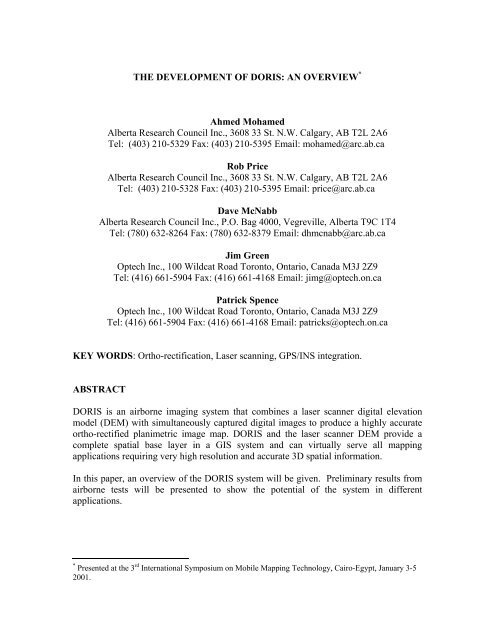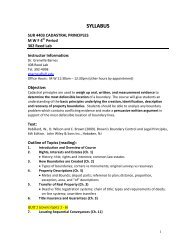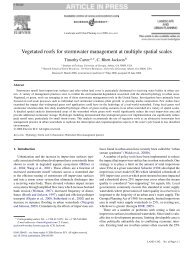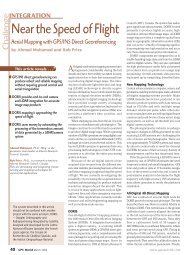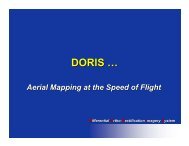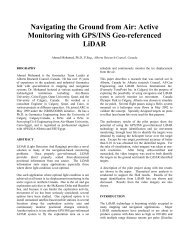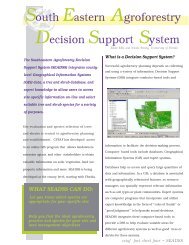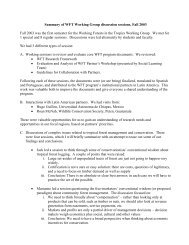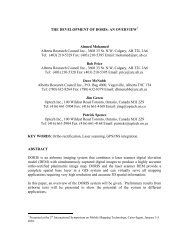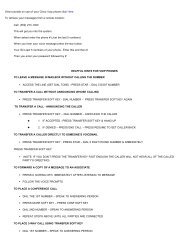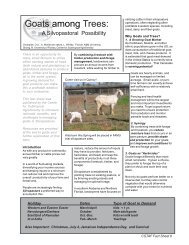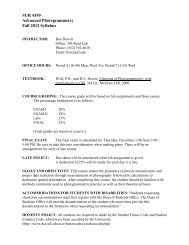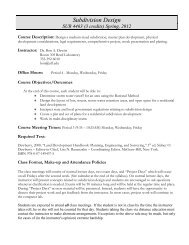THE DEVELOPMENT OF DORIS: AN OVERVIEW* Ahmed ...
THE DEVELOPMENT OF DORIS: AN OVERVIEW* Ahmed ...
THE DEVELOPMENT OF DORIS: AN OVERVIEW* Ahmed ...
Create successful ePaper yourself
Turn your PDF publications into a flip-book with our unique Google optimized e-Paper software.
<strong>THE</strong> <strong>DEVELOPMENT</strong> <strong>OF</strong> <strong>DORIS</strong>: <strong>AN</strong> OVERVIEW *<br />
<strong>Ahmed</strong> Mohamed<br />
Alberta Research Council Inc., 3608 33 St. N.W. Calgary, AB T2L 2A6<br />
Tel: (403) 210-5329 Fax: (403) 210-5395 Email: mohamed@arc.ab.ca<br />
Rob Price<br />
Alberta Research Council Inc., 3608 33 St. N.W. Calgary, AB T2L 2A6<br />
Tel: (403) 210-5328 Fax: (403) 210-5395 Email: price@arc.ab.ca<br />
Dave McNabb<br />
Alberta Research Council Inc., P.O. Bag 4000, Vegreville, Alberta T9C 1T4<br />
Tel: (780) 632-8264 Fax: (780) 632-8379 Email: dhmcnabb@arc.ab.ca<br />
Jim Green<br />
Optech Inc., 100 Wildcat Road Toronto, Ontario, Canada M3J 2Z9<br />
Tel: (416) 661-5904 Fax: (416) 661-4168 Email: jimg@optech.on.ca<br />
Patrick Spence<br />
Optech Inc., 100 Wildcat Road Toronto, Ontario, Canada M3J 2Z9<br />
Tel: (416) 661-5904 Fax: (416) 661-4168 Email: patricks@optech.on.ca<br />
KEY WORDS: Ortho-rectification, Laser scanning, GPS/INS integration.<br />
ABSTRACT<br />
<strong>DORIS</strong> is an airborne imaging system that combines a laser scanner digital elevation<br />
model (DEM) with simultaneously captured digital images to produce a highly accurate<br />
ortho-rectified planimetric image map. <strong>DORIS</strong> and the laser scanner DEM provide a<br />
complete spatial base layer in a GIS system and can virtually serve all mapping<br />
applications requiring very high resolution and accurate 3D spatial information.<br />
In this paper, an overview of the <strong>DORIS</strong> system will be given. Preliminary results from<br />
airborne tests will be presented to show the potential of the system in different<br />
applications.<br />
* rd<br />
Presented at the 3 International Symposium on Mobile Mapping Technology, Cairo-Egypt, January 3-5<br />
2001.
INTRODUCTION<br />
A suite of Geomatics and Remote Sensing (GRS) technologies for forest resources has<br />
been under development at Alberta Research Council for years [Pollock 1998a, Pollock<br />
1998b]. The focus of the new technology is on acquiring data for fundamental<br />
biophysical entities of sustainable forest eco-systems. Among the objectives of the GRS<br />
initiative is the opportunities for reducing the cost of the planning and conduct of forest<br />
operations [McNabb 2000a].<br />
Technology drivers for change include many readily available and developed tools. In<br />
the mapping area, GPS/INS, digital cameras, laser scanners, and GIS stand as crucial<br />
tools for modern mapping systems. Many new decision support tools and spatial planning<br />
models rely on this technology. In fact, the modern mapping technology can improve<br />
competitiveness and compensate for extensive, relatively low productivity land-based<br />
operations. For instance, high spatial resolution digital imagery provides significant<br />
advantages over many traditional image sources. To be most useful for forestry users,<br />
any imagery products must also be properly geo-referenced [Ackermann 1996,<br />
Quackenbush et. al. 2000].<br />
Management of Resources data is becoming increasingly complex because the objectives<br />
are dynamic in space and time. For instance, scale integration in forest resources is<br />
limited due to the limits imposed by the existing data. Traditional vegetation mapping<br />
approaches, for instance, require extensive field reconnaissance, and normally involve<br />
delineation of vegetation boundaries through interpretation of aerial photographs [Coulter<br />
et. al. 2000]. The inventory evolution of the resources information starts with the<br />
commodity and goes through some processes until the resource value is reached. Synergy<br />
is then achieved from integration of sensors and biophysical entities. With a synergy of<br />
tools, a platform can be built on which others can build additional applications, or is used<br />
by other management systems.<br />
The need for new tree inventory system stems from the fact that Canadian and Alberta<br />
inventories are poor [McNabb et. al. 2000b]. The sampling strategy for the current system<br />
is extensive and labor intensive. It is currently used for single purpose, wood supply. The<br />
new technology help provide critical measure of sustainability of harvest levels. As<br />
regards the landform and soil mapping, the need for new tools is driven by the fact that<br />
the current maps are poor at best and most forests have not been mapped. During the<br />
recent years, there has been increased interest in the increased value of water and other<br />
forest-related resources. The GRS adds forest productivity assessment and management<br />
tool which in turn maximizes potential for high resolution DEMs, predictive landform<br />
and soil mapping, and adds intelligent systems and decision support approach.<br />
The components of the GRS suites of technologies include aerial multi-sensor integration<br />
for data acquisition, tree imaging and forest inventory, landform and soil mapping under<br />
the umbrella of the integrated natural resources inventory and information system. The
driver for change is the need for high resolution, spatially accurate data. Scale integration<br />
from tree to stand to landscape and the multi-resource applications and values add<br />
improved forest inventory and growth forecast and site specific management [McNabb et.<br />
al. 2000b]. The focus of this paper is on the development and testing of a high-resolution<br />
spatially accurate data resource system called <strong>DORIS</strong> (Differential Ortho-Rectification<br />
Imagery System).<br />
SYSTEM DESCRIPTION<br />
The <strong>DORIS</strong> system consists of a hardware component and software one. In the<br />
following, a brief description will be given for both.<br />
<strong>DORIS</strong> Hardware Component<br />
The <strong>DORIS</strong> mapping system consists of an imaging component and a laser-scanning<br />
component. Although other imaging sensors are possible, the currently used imaging<br />
component of the <strong>DORIS</strong> system is a digital frame camera. The laser-scanning<br />
component of the system is an Airborne Laser Terrain Mapping lidar system. Both<br />
components are directly geo-referenced by a GPS/INS system on board of the platform.<br />
Fig. (1) illustrates the system as installed onboard of the airplane, while Fig. (2) shows<br />
the control unit of the system. The scanning-laser is an all-digital system that quickly and<br />
economically collects terrain data at high sample densities. Intelligent processing of laser<br />
data can classify the laser points as belonging to the terrain or belonging to objects near<br />
the ground, like vegetation, buildings, power lines, or other structures, see [Gutelius et.<br />
al. 1996] for more details. A Kodak Professional Digital Camera System is used in the<br />
proto-type of the <strong>DORIS</strong> system as an imaging sensor. The specific model DCS 520c that<br />
was used in the test flight is 3-color camera (RGB) with 12 bits/color and has a frame<br />
size of 1728x1152 pixels, where the actual pixel size on the CCD is 13 µm. A customized<br />
embedded Applanix POS/AV IMU and on-board NovAtel OEM3 Millennium GPS<br />
receiver provided the direct geo-referencing information to the <strong>DORIS</strong> system.<br />
Fig. (1): <strong>DORIS</strong> Hardware Fig. (2): <strong>DORIS</strong> Control Unit
<strong>DORIS</strong> Software Component<br />
The software part of the <strong>DORIS</strong> system has two components, field and processing. The<br />
field component consists of image acquisition (<strong>DORIS</strong>ia) software, imaging system<br />
calibration (<strong>DORIS</strong>cc) software, and a laser/camera fine alignment (<strong>DORIS</strong>fa) procedure.<br />
The processing component consists of software to provide laser DEM griding (gendem),<br />
image differential rectification software (DR) and Mosaic construction software<br />
(compose).<br />
Image Data Acquisition<br />
Images from a digital frame camera are<br />
acquired using <strong>DORIS</strong>ia software. In real<br />
time, the image frames are time-stamped<br />
and geo-referenced by the INS/GPS<br />
system. Time stamping involves a<br />
hardware communication component<br />
between the camera and the GPS receiver.<br />
Geo-referencing, however, involves<br />
processing the INS/GPS data, interpolating<br />
information at exposure stations and<br />
synchronizing the different data streams<br />
inside of the <strong>DORIS</strong> system. Fig. (3)<br />
illustrates the user interface of the<br />
<strong>DORIS</strong>ia software.<br />
Image System Calibration<br />
Fig. (3): <strong>DORIS</strong>ia Software<br />
For the imagery system to yield<br />
meaningful information, intrinsic and<br />
extrinsic parameters about the camera<br />
system must be known. The intrinsic<br />
camera parameters are its calibrated<br />
focal length, the location of the image<br />
principal point and the lens distortion<br />
characteristics. The extrinsic<br />
parameters, on the other hand, determine<br />
the relationship between the camera<br />
coordinate frame and the mapping<br />
coordinate frame. While it is<br />
recommended to calibrate the system in<br />
Fig. (4): <strong>DORIS</strong>cc Software<br />
lab conditions to yield optimum<br />
calibration results, it is possible to obtain an estimate of the calibration parameters inflight<br />
with a well-distributed target field in a designated calibration area. For the <strong>DORIS</strong><br />
system, the in-flight calibration is done for every installation of the system, while the lab
calibration is to be carried-out every year for maintenance purposes. Fig. (4) illustrates<br />
the user interface of the <strong>DORIS</strong>cc software.<br />
Laser/Camera Alignment<br />
The ALTM laser system provides the elevation model required for rectifying the imagery<br />
of the <strong>DORIS</strong> system. Because they are two distinct systems, the <strong>DORIS</strong> camera system<br />
and the laser-scanning system cannot occupy the same point in space at the same time.<br />
Therefore, the relationship between the camera coordinate system and the laser<br />
coordinate system should be defined. The definition of the camera-to-laser coordinate<br />
system relationship is done through a target field that is known/measured in both systems.<br />
This procedure also involves the on-board INS/GPS system. There are also several<br />
operational considerations that should be taken into account, for the tight coupling of the<br />
two systems.<br />
Laser DEM Girding<br />
The geometric final output of the laser scanner system<br />
is a DEM in a common coordinate system in the form<br />
of (x,y,z) coordinates of the laser-scanned points. Since<br />
the laser scans the area in a saw-tooth irregular form,<br />
the resulted DEM has to be grided in a regular raster<br />
format. This is purely a software task and involves<br />
estimating the elevation of the grid points from the<br />
neighboring laser-scanned points. The final raster DEM<br />
coincides with the image raster and determine the<br />
resolution of the final mosaic-map. Fig. (5) illustrates<br />
the user interface of the GenDEM software.<br />
Image Differential Rectification and Mosaicking<br />
The acquired images by <strong>DORIS</strong>ia, timestamped<br />
by GPS and geo-referenced by<br />
INS/GPS, are used along with the<br />
calibration information to compute the<br />
ground coordinates for each pixel of the<br />
non-rectified image. The ortho-rectification<br />
process involves correcting for relief<br />
displacement and platform disorientation<br />
[Wolf and Dewitt, 2000].<br />
A mosaic map with color balancing is then<br />
constructed from the individual rectified<br />
Fig. (5): <strong>DORIS</strong> GenDEM Software<br />
Fig. (6): <strong>DORIS</strong> DR Software
images. Fig. (6) illustrates the user interface of the DR software.<br />
<strong>DORIS</strong> Information Flow<br />
The <strong>DORIS</strong> process starts with acquiring the camera and laser scanner data. After<br />
processing the laser data, a non-raster digital terrain model (DEM) is acquired. A raster<br />
DEM is then produced by griding the laser ground points. The camera data, on the other<br />
hand, is corrected by the calibration parameters to produce calibrated non-differentially<br />
rectified (NDR) images. Both the DEM and the NDR images along with the georeferencing<br />
information are input to the image differential rectification and mosaic<br />
module to first rectify the images and then produce the mosaic map.<br />
FLIGHT TEST<br />
A flight test was carried out in the<br />
Greater Toronto area-Ontario, Canada<br />
in April 1999 to test the <strong>DORIS</strong> prototype<br />
system. The flight included a<br />
calibration site and an operation one.<br />
The calibration site was flown more<br />
than once and in two perpendicular<br />
directions, namely in a near east-west<br />
direction and a near north-south one.<br />
Two perpendicular directions were<br />
specifically chosen to de-correlate<br />
direction-related errors. Multiple<br />
calibration lines of flight were flown to<br />
strengthen the calibration/alignment<br />
Fig. (7): Flight Trajectory over the<br />
Calibration Site<br />
procedure and allow for redundancy. Fig. (7) shows the trajectory of one of the flights<br />
over the calibration site.<br />
The calibration site included a building with a long straight side to calibrate and fine-tune<br />
the laser-scanning system. The corners on top of the roof of the calibration building were<br />
precisely surveyed using differential GPS. A number of ground control targets were also<br />
surveyed using the same GPS technique. The ground targets were two-meter by twometer<br />
canvases with black and white x-like symbol. The total number of building-corners<br />
and ground control targets were about 40. The proto-type configuration and the average<br />
flying height above ground for this specific test resulted in an average ground pixel size<br />
of 0.30 meter.
ERROR BUDGET<br />
Because the <strong>DORIS</strong> system has multi sensors,<br />
the overall positioning accuracy of the system is<br />
a result of a combination of error sources. Fig.<br />
(8) illustrates the different coordinate frames<br />
used in the <strong>DORIS</strong> system.<br />
The error budget of the <strong>DORIS</strong> system is<br />
affected by the following two main factors,<br />
intrinsic parameters and extrinsic parameters.<br />
The intrinsic parameters include camera lens<br />
calibrated focal length, location of CCD<br />
principal point, and lens distortion<br />
characteristics. The extrinsic parameters, on the<br />
other hand, include camera coordinate frame to<br />
mapping coordinate frame alignment, camera<br />
coordinate frame to laser (user) coordinate<br />
frame alignment, camera system measurement<br />
errors, laser system measurement errors and<br />
GPS/INS geo-referencing system errors. The<br />
error sources can be summarized as due to:<br />
• Geo-referencing<br />
• Pixel estimation<br />
• Calibration and alignment.<br />
The above different sources of errors can be<br />
described in an equation form as follows:<br />
X + S R r + ∆r<br />
e = e + e + e<br />
2<br />
p<br />
l l<br />
p = X GPS /<br />
INS<br />
2<br />
GPS / INS<br />
2<br />
i<br />
c<br />
l<br />
c<br />
c<br />
2<br />
CLA<br />
Eq. (1)<br />
Where:<br />
First term: positioning error due to the direct georeferencing<br />
system,<br />
Second term: position estimation error in the<br />
imaging system,<br />
Last term: error due to calibration and alignment<br />
process.<br />
i<br />
c<br />
Imaging Frame<br />
(Camera)<br />
Object<br />
Navigation Frame<br />
(GPS)<br />
User Frame<br />
(Laser)<br />
Fig. (8): <strong>DORIS</strong> System<br />
Coordinate Frames<br />
Body Frame<br />
(INS)<br />
The positioning error due to the direct geo-referencing system is most pronounced at the<br />
edges of the image frames. This is partially due to the direct effect of the IMU on the<br />
attitude information and due to its indirect effect on the laser DEM. The error due to the
imaging system is also most pronounced on the edges of the image frames due to mainly<br />
the lens distortion characteristics. Compensation of lens distortion, incorrect principal<br />
point estimation and imperfect focal length contribute make up most of the error. The<br />
rectification estimation algorithm is also a contributing factor to that error. Error due to<br />
mis-alignment between the camera system and the laser-scanning system is systematic in<br />
nature and contribute a large value in the overall error budget.<br />
TEST RESULTS<br />
Table (1) shows horizontal errors by comparing the coordinates of the GPS-surveyed<br />
control points to the computed coordinates of the same points on the images after being<br />
calibrated and ortho-rectified. Because two different types of control points were used,<br />
two sets of results are presented in the table.<br />
Results from ground targets only show more consistency (better standard deviation) than<br />
results from all the points (building corners and ground targets). The uncertainty in<br />
defining the image and ground coordinates of the building corners is the obvious reason<br />
for that. While it was easy to define and measure the ground targets, the shadow effect at<br />
the building edges limited the ability to correctly define the corner points.<br />
Considering the pixel size of 0.30 m for this flight test, the standard deviation of the<br />
errors of 0.20 m is two-thirds of a pixel. In other words, within an image frame, errors of<br />
less than 0.20 m are expected to happen 67% of the time. The concentration of this type<br />
of error is most likely to happen around the middle of the image frame. Errors as large as<br />
0.60 m (3σ) are expected to happen close to the edge of the image frame due to lens<br />
distortion and geo-referencing problems close to the swath edge.<br />
The bias in the error is due to two factors, long GPS baseline and misalignment. Because<br />
the master GPS station happened to be more than 50 km away from the calibration site,<br />
the residual atmospheric effect manifested itself as a bias in the final solution. Also,<br />
residual misalignment between the camera system and the laser system shows the same<br />
behavior. Adding the bias to the final results, the ‘rms’ error is approximately one and<br />
two-thirds of the pixel size.<br />
Table (1): Horizontal Position Errors<br />
Points Error [m] E N |E| |N|<br />
Mean 0.28 0.01 0.46 0.37<br />
All<br />
Points<br />
Ground<br />
Targets<br />
Only<br />
Max 0.80 0.80 0.80 0.80<br />
Min -0.66 -0.62 0.01 0.03<br />
Sd 0.44 0.44 0.22 0.23<br />
Rms 0.52 0.44 0.51 0.44<br />
Mean 0.46 -0.28 0.46 0.28<br />
Max 0.59 -0.07 0.59 0.62<br />
Min 0.06 -0.62 0.06 0.07<br />
Sd 0.18 0.20 0.18 0.20<br />
Rms 0.49 0.35 0.49 0.35
Fig. (9) shows a final <strong>DORIS</strong> image mosaic. Fig. (9a) shows a mosaic of a few image<br />
frames on a UTM grid. Fig. (9b) shows a building corner using only the laser data; it can<br />
be noticed how dense the laser points are to the limit that a building corner can be<br />
identified. Fig. (9c) shows a mosaic seam horizontally across two image frames and the<br />
produced color balancing. Fig. (9d) shows a ground target canvas and the corresponding<br />
computed position of it on the mosaic map.<br />
SUMMARY <strong>AN</strong>D OUTLOOK<br />
The aim of the suite of Geomatics and Remote Sensing (GRS) technologies for forest<br />
resources is to reduce the cost of the planning and conduct of forest operations. The<br />
initiative also includes building tools for tree inventory and better management of the<br />
forest resources. . With a synergy of tools, a platform can be built on which others can<br />
build additional applications, or is used by other management systems.<br />
An airborne multi-sensor mapping system has been under development for years at<br />
Alberta Research Council under the GRS initiative. <strong>DORIS</strong> combines a laser-scanning<br />
technology with digital imaging technology to produce high-resolution and highly<br />
accurate ortho-rectified planimetric image map. With the laser scanner DEM, <strong>DORIS</strong><br />
provides a complete spatial base layer in a GIS system and can virtually serve all<br />
mapping applications requiring very high resolution and accurate 3D spatial information.<br />
The <strong>DORIS</strong> system is all digital and highly automated because of its inherent structure. It<br />
uses state-of-the-art direct geo-referencing provided by a highly accurate GPS/INS<br />
system. Very fast turn-around time is possible with the <strong>DORIS</strong> system due to its digital<br />
nature and high automation.<br />
The overall error budget shows promising results of the system due to the highly accurate<br />
hardware and software components and procedures. Test results show sub-pixel accuracy<br />
(1σ) within the mosaic map. Systematic errors and biases due to atmospheric and<br />
calibration effects contribute to the overall system accuracy. Errors due to mis-alignment<br />
between the imaging system and the laser-scanning system contribute considerably to the<br />
overall system accuracy.<br />
The high-resolution capability of the <strong>DORIS</strong> system and its high accuracy and fast turnaround<br />
time make it an ideal system for forest resources and other mapping applications<br />
that require such capabilities. It also provides short wave length information that, when<br />
combined with high-resolution satellite imagery, can provide a very economic and<br />
feasible system.
SUMMARY<br />
Normal text<br />
Fig. (9a): ALTM raster Laser DEM<br />
Fig. (9c): Seamless mosaic with color<br />
balancing<br />
Fig. (9d): Sub-pixel accuracy (image<br />
compared to ground control<br />
targets)<br />
Fig. (9): <strong>DORIS</strong> Mosaic Map of the Calibration Site<br />
Fig. (9a): <strong>DORIS</strong> Airborne mosaic air photo scale 1:25000 with<br />
Kodak DCS 520 Professional Digital Camera
REFERENCES<br />
Ackermann, Friedrich (1996). Airborne Laser Scanning for Elevation Models. GIM<br />
Geomatics Info Magazine, Vol. 10, October 1996.<br />
Coulter, Lloyd, Douglas Stow, Allen Hope, John O’Leary, Debbie Turner, Pauline<br />
Longmire, Seth Peterson, John Kaiser (2000). Comparison of High Spatial Resolution<br />
Imagery for Efficient Generation of GIS Vegetation Layers. Photogrammetry<br />
Engineering and Remote Sensing Journal, Volume 66, Number 11, November 2000.<br />
Gutelius, Bill, Donald Carswell, Jim Green (1996). Topographic Terrain Mapping<br />
Using Scanning Airborne Laser Radar. GPS/LIS’96 Conference, Denver - Colorado,<br />
Nov. 19-21 1996.<br />
McNabb, Dave (2000a). Geomatics and Remote Sensing Program, Forest Resources<br />
response to social, market, and technology changes in the Forestry Sector. FORES&T<br />
2000 Workshop: Toward sustainability and improved competitiveness, Alberta Research<br />
Council, Edmonton, Alberta, Canada, October 18-20, 2000.<br />
McNabb, Dave, <strong>Ahmed</strong> Mohamed, Rob Price, Jim Green (2000b). High Quality Base<br />
Maps for the Planning and Conduct of Forest Operations. GPS in Forestry:<br />
Workshop 2000, The Grand Okanagan Lakefront Resort and Conference Center,<br />
Kelowna, British Columbia, Canada, November 20 - 22, 2000.<br />
Pollock, Richard (1998a). Overview of the Differential Rectification and Mosaic<br />
Composition Software. Advanced Computing Business Unit, Alberta Research<br />
Council, Calgary, Alberta, Canada.<br />
Pollock, Richard (1998b). Development of Highly automated System for the Remote<br />
Evaluation of Individual Tree Parameters. Advanced Computing Business Unit,<br />
Alberta Research Council, Calgary, Alberta, Canada.<br />
Quackenbush, Lindi J., Paul F. Hopkins, Gerald J. Kinn (2000). Developing Forestry<br />
Products from High Resolution Digital Aerial Imagery. Photogrammetry Engineering<br />
and Remote Sensing Journal, Volume 66, Number 11, November 2000.<br />
Wolf, Paul R., Bon A. Dewitt (2000). Elements of Photogrammetry with Applications<br />
in GIS. McGraw Hill, New York.


